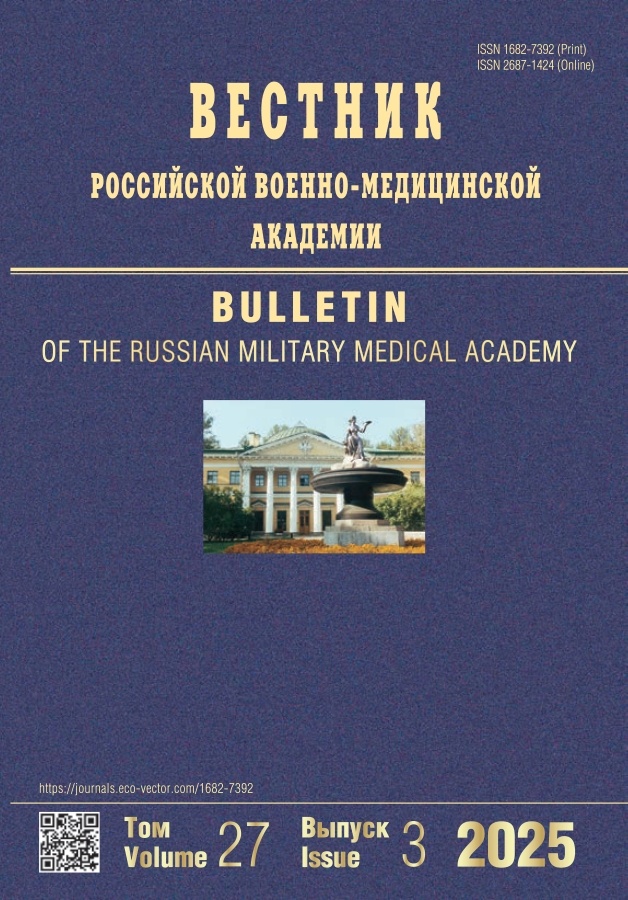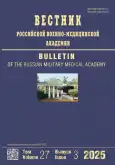Гипоксия и новая коронавирусная инфекция: индуцируемый гипоксией фактор 1-альфа как маркер тяжести заболевания и новая терапевтическая мишень
- Авторы: Ефимов С.В.1,2, Любимов А.В.1,3, Черкашин Д.В.1, Тарахтеев А.С.1, Быкова Д.Д.1, Васильев В.В.4, Трандина А.Е.1, Погожая Е.А.5
-
Учреждения:
- Военно-медицинская академия им. С.М. Кирова
- Санкт-Петербургский медико-социальный институт
- Институт экспериментальной медицины
- Филиал № 1 425-го военного госпиталя
- Медицинский центр преморбидных и неотложных состояний Центрального военного клинического госпиталя имени П.В. Мандрыка
- Выпуск: Том 27, № 3 (2025)
- Страницы: 367-374
- Раздел: Оригинальное исследование
- URL: https://bakhtiniada.ru/1682-7392/article/view/319568
- DOI: https://doi.org/10.17816/brmma643305
- EDN: https://elibrary.ru/LQMOQV
- ID: 319568
Цитировать
Аннотация
Обоснование. Гипоксия играет ключевую роль в патогенезе новой коронавирусной инфекции, усиливая воспалительные процессы и способствуя развитию осложнений. Индуцируемый гипоксией фактор 1-альфа выступает важным регулятором адаптации организма к кислородному дефициту. Изучение динамики уровня индуцируемого гипоксией фактора 1-альфа у больных новой коронавирусной инфекцией позволит уточнить патогенетические механизмы заболевания и определить перспективные терапевтические мишени.
Цель исследования — оценить роль индуцируемого гипоксией фактора 1-альфа в процессах компенсации и адаптации организма к гипоксическому стрессу при новой коронавирусной инфекции.
Методы. В период с января 2020 г. по март 2022 г. в клинике военно-морской терапии Военно-медицинской академии им. С.М. Кирова обследованы 295 пациентов, 272 из которых имели подтвержденный диагноз новой коронавирусной инфекции. Пациенты были разделены на три возрастные группы согласно классификации Всемирной организации здравоохранения: 1-я группа (молодой возраст) — 207 пациентов; 2-я группа (средний возраст) — 56 пациентов; 3-я группа (пожилой возраст) — 32 пациента. Уровень индуцируемого гипоксией фактора 1-альфа в сыворотке крови определяли с помощью иммуноферментного анализа. Статистическую обработку данных проводили с использованием программ GraphPad Prism 8 и IBM SPSS Statistics. Статистическая значимость результатов оценивалась при p <0,05.
Результаты. Установлено, что уровень индуцируемого гипоксией фактора 1-альфа коррелирует с возрастом и тяжестью течения новой коронавирусной инфекции, достигая максимума у пациентов пожилого возраста с тяжелыми формами заболевания. Уровень индуцируемого гипоксией фактора 1-альфа снижался в период реконвалесценции, отражая адаптацию организма после прекращения гипоксического стресса. В группе пожилых пациентов выявлены более высокие значения индуцируемого гипоксией фактора 1-альфа при легком течении новой коронавирусной инфекции, что связано с сопутствующей коморбидной патологией.
Заключение. Полученные данные подтверждают значимость индуцируемого гипоксией фактора 1-альфа как маркера тяжести гипоксических состояний при новой коронавирусной инфекции и подчеркивают его потенциальную роль в качестве терапевтической мишени. Дальнейшие исследования необходимы для уточнения молекулярных механизмов его регуляции и разработки стратегий фармакологической коррекции гипоксических нарушений.
Полный текст
Открыть статью на сайте журналаОб авторах
Семен Валерьевич Ефимов
Военно-медицинская академия им. С.М. Кирова; Санкт-Петербургский медико-социальный институт
Автор, ответственный за переписку.
Email: vmeda-nio@mil.ru
ORCID iD: 0000-0002-0384-3359
SPIN-код: 6351-6832
канд. мед. наук
Россия, 194044, Санкт-Петербург, ул. Академика Лебедева, д. 6Ж; Санкт-ПетербургАндрей Владимирович Любимов
Военно-медицинская академия им. С.М. Кирова; Институт экспериментальной медицины
Email: vmeda-nio@mil.ru
ORCID iD: 0000-0001-9829-4681
SPIN-код: 5307-4186
канд. мед. наук
Россия, Санкт-Петербург; Санкт-ПетербургДмитрий Викторович Черкашин
Военно-медицинская академия им. С.М. Кирова
Email: vmeda-nio@mil.ru
ORCID iD: 0000-0003-1363-6860
SPIN-код: 2781-9507
д-р мед. наук, профессор
Россия, Санкт-ПетербургАнтон Сергеевич Тарахтеев
Военно-медицинская академия им. С.М. Кирова
Email: vmeda-nio@mil.ru
ORCID iD: 0009-0006-4294-1839
SPIN-код: 9657-2590
курсант
Россия, Санкт-ПетербургДиана Дмитриевна Быкова
Военно-медицинская академия им. С.М. Кирова
Email: vmeda-nio@mil.ru
ORCID iD: 0009-0009-7450-6411
SPIN-код: 4909-7667
курсант
Россия, Санкт-ПетербургВладислав Вячеславович Васильев
Филиал № 1 425-го военного госпиталя
Email: vmeda-nio@mil.ru
ORCID iD: 0009-0003-9489-979X
SPIN-код: 3525-5337
ординатор отделения
Россия, ИркутскАлександра Евгеньевна Трандина
Военно-медицинская академия им. С.М. Кирова
Email: vmeda-nio@mil.ru
ORCID iD: 0000-0003-1875-1059
SPIN-код: 6089-3495
врач лабораторной диагностики
Россия, Санкт-ПетербургЕлена Андреевна Погожая
Медицинский центр преморбидных и неотложных состояний Центрального военного клинического госпиталя имени П.В. Мандрыка
Email: vmeda-nio@mil.ru
ORCID iD: 0009-0009-5996-166X
SPIN-код: 7542-5026
врач медицинского отдела
Россия, МоскваСписок литературы
- Serebrovska ZO, Chong EY, Serebrovska TV, et al. Hypoxia, HIF-1α, and COVID-19: from pathogenic factors to potential therapeutic targets. Acta Pharmacologica Sinica. 2020;41(12):1539–1546. doi: 10.1038/s41401-020-00554-8 EDN: ZOWZPC
- Sabirov I, Mamedova K, Sultanova M, et al. The role and significance of the hypoxic component in the development of complications of COVID-19. Scientific Heritage. 2021;(62-2):21–28. doi: 10.24412/9215-0365-2021-62-2-21-28 EDN: QWHHBA
- Rahman A, Tabassum T, Araf Y, et al. Silent hypoxia in COVID-19: pathomechanism and possible management strategy. Mol Biol Rep. 2021;48(4):3863–3869. doi: 10.1007/s11033-021-06358-1 EDN: FIIYPN
- Lyubimov AV, Cherkashin DV, Efimov SV, et al. Mechanisms and triggers of adaptation to hypoxia. Reviews on Clinical Pharmacology and Drug Therapy. 2021;19(3):269–280. doi: 10.17816/RCF193269-280 EDN: NDYWMH
- Mitroshina EV, Savyuk MO, Ponimaskin E, et al. Hypoxia-inducible factor (HIF) in ischemic stroke and neurodegenerative disease. Front Cell Dev Biol. 2021;9:703084. doi: 10.3389/fcell.2021.703084 EDN: CBZODC
- Kalinin RE, Suchkov IA, Raitsev SN, et al. Role of hypoxia-inducible factor 1α in adaptation to hypoxia in pathogenesis of novel coronavirus disease 2019. I.P. Pavlov Russian Medical Biological Herald. 2024;32(1):133–144. doi: 10.17816/PAVLOVJ16553 EDN: PFOGIO
- Jahani M, Dokaneheifard S, Mansouri K. Hypoxia: A key feature of COVID-19 launching activation of HIF-1 and cytokine storm. J Inflamm (Lond). 2020;17:33. doi: 10.1186/s12950-020-00263-3 EDN: GIPMEH
- Guo W, Li M, Dong Y, et al. Diabetes is a risk factor for the progression and prognosis of COVID-19. Diabetes Metab Res Rev. 2020;36(7):e3319. doi: 10.1002/dmrr.3319 EDN: ZJITDV
- Jordan RE, Adab P, Cheng KK. COVID-19: risk factors for severe disease and death. BMJ. 2020;368:m1198. doi: 10.1136/bmj.m1198
- Andreenko AA, Andreychuk YuV, Arsentiev VG, et al. Epidemiology of the new coronavirus infection (COVID-19). In: Infection Caused by SARS-COV-2. Saint Petersburg: Kirov Military Medical Academy; 2023. P. 17–22. EDN: QFKFPF (In Russ.)
- Vassilaki N, Frakolaki E. Virus-host interactions under hypoxia. Microbes Infect. 2017;19(3):193–203. doi: 10.1016/j.micinf.2016.10.004 EDN: YWACOH
- Bourgonje AR, Abdulle AE, Timens W, et al. Angiotensin-converting enzyme 2 (ACE2), SARS-CoV-2 and the pathophysiology of coronavirus disease 2019 (COVID-19). J Pathol. 2020;251(3):228–248. doi: 10.1002/path.5471 EDN: QHGXPH
- Zhang R, Wu Y, Zhao M, et al. Role of HIF-1α in the regulation ACE and ACE2 expression in hypoxic human pulmonary artery smooth muscle cells. Am J Physiol Lung Cell Mol Physiol. 2009;297(4):L631–L640. doi: 10.1152/ajplung.90415.2008
- Codo AC, Davanzo GG, Monteiro LB, et al. Elevated glucose levels favor SARS-CoV-2 infection and monocyte response through a HIF-1α/glycolysis-dependent axis. Cell Metab. 2020;32(3):437–446. doi: 10.1016/j.cmet.2020.07.007
- May L, Chu CF, Zielinski CE. Single-cell RNA sequencing reveals HIF1A as a severity-sensitive immunological scar in circulating monocytes of convalescent comorbidity-free COVID-19 patients. Cells. 2024;13(4):300. doi: 10.3390/cells13040300 EDN: HZQZXS
- Lazzeri M, Lanza A, Bellini R, et al. Respiratory physiotherapy in patients with COVID-19 infection in acute setting: a position paper of the Italian association of respiratory physiotherapists (ARIR). Monaldi Arch Chest Dis. 2020;90(1). doi: 10.4081/monaldi.2020.1285 EDN: IHWHJH
- He J, Wu B, Chen Y, et al. Characteristic electrocardiographic manifestations in patients with COVID-19. Can J Cardiol. 2020;36(6):966.e1–966.e4. doi: 10.1016/j.cjca.2020.03.028 EDN: WEYHIF
- Bickler PE, Feiner JR, Lipnick MS, et al. ”Silent” presentation of hypoxemia and cardiorespiratory compensation in COVID-19. Anesthesiology. 2021;134(2):262–269. doi: 10.1097/ALN.0000000000003578
- Batah SS, Fabro AT. Pulmonary pathology of ARDS in COVID-19: A pathological review for clinicians. Respir Med. 2021;176:106239. doi: 10.1016/j.rmed.2020.106239 EDN: GZVJPH
- Yeo EJ. Hypoxia and aging. Exp Mol Med. 2019;51(6):1–15. doi: 10.1038/s12276-019-0233-3 EDN: ELMSKX
- Lahiri S, Antosiewicz J, Pokorski M. A common oxygen sensor regulates the sensory discharge and glomus cell HIF-1alpha in the rat carotid body. J Physiol Pharmacol. 2007;58(5):327–333.
- Semenza GL. Regulation of mammalian O2 homeostasis by hypoxia-inducible factor 1. Annu Rev Cell Dev Biol. 1999;15:551–578. doi: 10.1146/annurev.cellbio.15.1.551
- Chen J, Huang X, Tao C, et al. Berberine chloride suppresses non-small cell lung cancer by deregulating Sin3A/TOP2B pathway in vitro and in vivo. Cancer Chemother Pharmacol. 2020;86(1):151–161. doi: 10.1007/s00280-020-04050-y EDN: JMYAUA
- Gao H, Nepovimova E, Heger Z, et al. Role of hypoxia in cellular senescence. Pharmacol Res. 2023;194:106841. doi: 10.1016/j.phrs.2023.106841 EDN: QZEQGF
Дополнительные файлы












